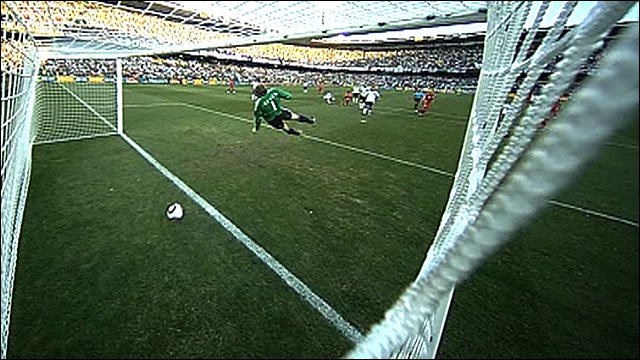
Soccer, or football as it is known outside of North America, is widely considered the world’s most popular sport. It not only means that this sport and its players are among the most famous, but it is also the most scrutinized sport in the world. Quite possibly the most scrutinized aspect involves the goal line and determining if the ball has crossed the line or not. The NHL, NFL, and MLB have all have used technology to settle scoring disputes and FIFA was lagging behind and it appear that the 2010 World Cup has changed the soccer organization’s outlook on this topic.
One of the most famous missed calls in recent memory was the round of sixteen match between Germany and England, in which Germany won 4 to 1. Late in the first half with Germany up 2 goals to 1, Steven Gerrad lobbed the ball past the German keeper, Manuel Neuer, and over the goal line but the ball bounced back out and the referee waved for play to continue. This non goal demoralized the English side and Germany went on their way to the quarterfinals. With this glaring mistake FIFA president apologized to the English national team and now the soccer organization is trying to implement goal line technology to help referees make correct calls.
In a true twist that might be considered karmic, England defeated Ukraine in their final round robin match at this year’s Euro Cup tournament, allowing them to advance to the quarter finals in a much win game. This high profile event might be the straw that broke the camel’s back, as indicated in this article.
There are currently two options for FIFA to choose from, Hawk-eye and GoalRef. Many people may know Hawk-eye from cricket and tennis and the system uses cameras and trajectories to determine the placement of the ball. For soccer there will be multiple cameras in each goal and it will determine if the ball has crossed the goal line or not. The English Premier League has shown interest in this system and hopes to use it as early as the 2012-2013 season, but the Premiere League may have to wait longer. The Hawk-eye system is currently in review and will be discussed in International Football Association Board July meeting. One disadvantage of the Hawk-eye is the high cost to install the system for each field, while GoalRef is cheaper to install. Another downside is that each camera must see at least 25 percent of the ball to determine the trajectory.
The other option, GoalRef, is being considered by FIFA as well and this system is quite different than Hawk-eye. GoalRef requires a magnetic field set up around the goal area and there is a chip in the soccer ball. Once the ball crosses the goal line sensors will send a signal to the referee’s watch indicating the goal. In this scenario there is no need for cameras and the chip seems to be compatible with any soccer ball.
Both systems are being considered by FIFA and they could both be approved. With technology that will help determine goals mistakes such as the 2010 World Cup match between Germany and England could be avoided. Hawk-Eye seems to have some obstacles in their way, but with the English Premier League it could help its chances for being passed by FIFA’s board. Whether one or both systems are approved it is a move into the right direction for a sport that is loved all over the world.